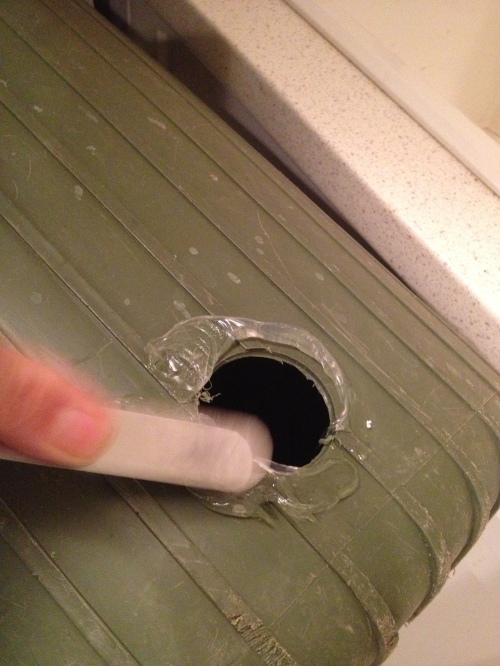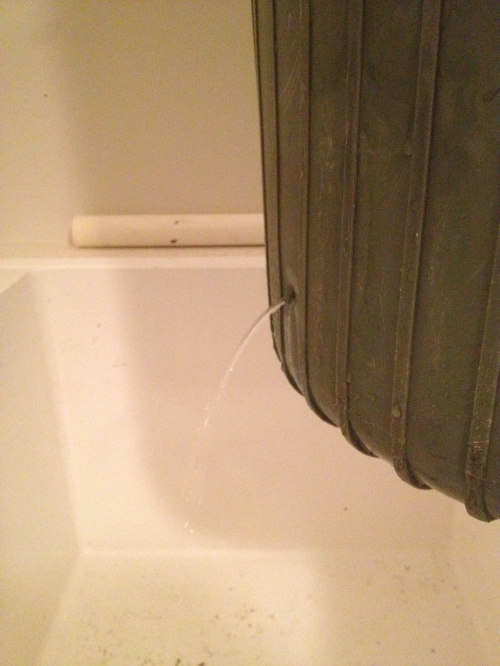
Dad recalls all kinds of slogans from the war and post-war years. “Make Do and Mend” was one of them. [E. colin Williams]
The hog water troughs have long proved to be a challenge – the pigs love to dump them over, climb into them, fill their mouths with dirt and then rinse and spit into them…
The ducks are the only creatures who are perhaps even worse at fouling (fowling?) containers of water. They blow their beaks under water to clear out the mud and sludge they accumulate while sifting through sludge looking for… whatever they are looking for. Anyway, between that delightful habit, their incessant splashing and dunking, and the liberal amounts of poop they deposit while they are busy floating around in places they don’t belong, they make a mess of the hog water quicker than you can say, “[Duck] Bottoms Up!”
With all that in mind, I decided to try a new watering system for the hogs. Inspired by a similar set-up over at my neighbour’s place, I bought a hog nipple and a couple of threaded bits so I could convert a garbage can into a covered watering system.
Dad and I set about installing what appeared to be a pretty simple set-up. We wrapped all the relevant threads in plumber’s tape, drilled a big hole in the side of the plastic garbage can, and then proceeded to fasten all the bits together. We screwed the hog nipple into Part A, put Part A a on the outside of the garbage can and then threaded Part B onto Part A, but inside the garbage can, sandwiching the wall of the can between the two parts. Sounds ludicrously complicated but was actually very simple.

Hog nipple screwed into Part A. If only I’d paid more attention at the farm supply store as to what Part A was actually called… Threaded collar into which a hog nipple is inserted… The red ring is the outside cover of the roll of plumber’s tape.
We put some water in the garbage can so it just covered the new hog nipple installation and went and had dinner.
When we returned to check on the water level, it had dropped to just below the ring. We figured we didn’t have a good enough seal, perhaps due to the ridges on the garbage can, so we dug out our our handy dandy Roof Patch stuff and applied it liberally.

Roof Patch goop – can be applied wet – guaranteed to stop leaks. We also added more plumber’s tape for good measure.
We repeated the water test and… noticed that the water level was dropping even more rapidly. Not only that, there was the distinctive sound of water dribbling… A closer inspection revealed that the problem had nothing to do with the nipple installation but everything to do with a nail-sized puncture wound on the back side of the garbage can!
At this point in the proceedings Dad had a nostalgia attack.
“”What we need here are pot menders.”
This elicited a blank look from me. Pot menders? Who mends pots, anyway? Apparently, during and after WWII, all of England was told to mend their pots by none other than the Queen.This was done using something called pot menders. The following image showed up in my email inbox at 2am that night as Dad thought he was losing his mind and remembering something that never existed.
Sure enough, these double washer-type doohickeys were fastened together on either side of the hole in the kettle or pot, fixing the broken item. It occurred to me that these days if my kettle stops working I run out and buy a new one and toss the old one in the trash bin. I don’t think you could buy anything like this any more, except maybe on E-bay and besides, I don’t think plastic would respond well to this treatment.
Needless to say, our supply of pot menders was non existent, so we cast our minds around to see if we could find another solution. Duct tape? Pond liner patches glued to the inside of the can with Roof Patch goop? Some sort of rubbery plug?
In a flash of inspiration Dad thought of roofing screws which are backed with a built-in rubber washer. We found one, slathered it with Roof Patch goop, and screwed it (gently) into the hole. Roofing screw to the rescue!
Roofing screw to the rescue! Our improvised version of a pot mender in position.
Our improvised version of a pot mender in position.
The final step was to add water and wait. The can sat overnight and we lost nary a drop of water!
The next big hurdle is installing it in the hog paddock in such a way that the hogs can’t tip it over. Stay tuned… because, yes, there is yet more to come on the subject of water containers…












I have heard of the pot menders, but only because my 83 year old friend blogged about them. LOL! I was imagining two washers and a wing nut or carriage bolt for your fix. Your fix looks less expensive and easier to apply! I enjoy your bucket reports because I may well need your expertise for when we move. Forewarned is forearmed as they say. 😉
LikeLike
An 83 year old blogger – I love it! What’s the blog called?
LikeLike
Her blog is “Lillian’s Cupboard” and you can find her here: http://lillianscupboard.wordpress.com/
She quilts, cooks, and shares bits and bobs from her life in Ohio. I have so much fun looking into the past through her writing and her photographs. Enjoy! 🙂
LikeLike
Thank you!
LikeLike
LOL I don’t know. I think those of us who obsess over getting water to our animals in bad weather need to be sharing our clever solutions, especially right now.
LikeLike
Technical terms after my own heart. I personally use “chummy” quite a bit, a technical term I picked up in the Navy eons ago…
Actually, still on the Navy, they’ve theoretically done away with this in recent years, but it used to be very common (certainly all through “my” time in the 80/90s) when not at sea for one’s chief to come along on Fridays and say, “This afternoon we’ll have a make and mend”. This was Navy speak for an afternoon off – not an official one, but one where you just quietly make yourself scarce. It was time off given for attending to personal business – in my time that meant dry cleaning, the bank, etc, but in my Dad’s time it still meant darning your socks, sewing your buttons on, and generally getting your belongings shipshape.
I’m actually planning to use this very method of watering the pigs this summer, as they’ll be too far from a tap to conveniently run a hose from, which is how I had their nipple hooked up last year. So thank you for the tutorial!
LikeLike
When you had the nipple hooked directly to the hose, how did you stop the pigs from playing with/biting the hose?
I’ll have to ask Dad if they had make and mend afternoons when he served in the army…
LikeLike
I bought a brass chummy :)…it was a brass adapter bit of pipe, from Sleggs – about 6 inches long, male on both ends, you can get the ends different widths (hence adapter), and I strapped that to a fence post with the hose on the other side from the pigs…they could chew on the brass bit of pipe all they wanted.
LikeLike
Well, I don’t have livestock to water, but somehow still found this entertaining. I think we need a little more make do and mend… of course, retailers would disagree!
LikeLike
Thanks for reading and commenting even though your life does not revolve around water buckets! Can you imagine what retailers would say if we declared a Make and Mend Day instead of Black Friday?
LikeLike
Ha – sounds like a great idea. I suspect retailers would then push Christmas adverts to July instead of October and find some way to sell “necessary” items to sell to help with that make and mend. :).
LikeLike
No doubt! You just can’t win…
LikeLike
Are you kidding? Boring? I live for this stuff! The only way I can stay on my land is to make do and mend and design by the seat of my pants. And your Dad is awesome. Pot menders, yes!
LikeLike
That’s a relief! I live for this stuff, too – but I’m sure there are those whose eyes roll when they see another post beginning with… ‘today I had to fix… move… retrieve… load… shovel… thaw… burn… haul… schlepp… feed… catch… shear… milk… ‘
LikeLike
As a city person, I have never had to do this kind of repair. But, my late husband always built and fixed things as they broke instead of buying new when he could. I find a lot of his “creations” and fixes all the time and am reminded of this talent for this type of thing now when I can’t do these creative fixes.
LikeLike
It must be hard to find those reminders… and good at the same time. I bet those finds bring back some great memories. Thanks for sharing…
LikeLike